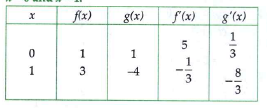Let f be a function with continuous second derivative and f(0)=f′(0)=0. Determine a function g by g(x)={f(x)x,x≠00,x=0 Then which of the following statements is correct? g has a continuous first derivative g has a first derivative g is continuous but g fails to have a derivative g has a first derivative but the first derivative is not continuousSolution in Tamil
Step by step video & image solution for Let f be a function with continuous second derivative and f(0)=f^(prime)(0)=0. Determine a function g by g(x)={(f(x))/x ,x!=0 0,x=0 Then which of the following statements is correct? g has a continuous first derivative g has a first derivative g is continuous but g fails to have a derivative g has a first derivative but the first derivative is not continuous by Maths experts to help you in doubts & scoring excellent marks in Class 12 exams.
Updated on:21/07/2023Similar Questions
Let f be a function with continuous second derivative and f(0)=f′(0)=0. Determine a function g by g(x)={f(x)x,x≠00,x=0 Then which of the following statements is correct? g has a continuous first derivative g has a first derivative g is continuous but g fails to have a derivative g has a first derivative but the first derivative is not continuous
View SolutionIf f(x−y)=f(x).g(y)−f(y).g(x) and g(x−y)=g(x).g(y)+f(x).f(y) for all x∈R . If right handed derivative at x=0 exists for f(x) find the derivative of g(x) at x =0
View Solutionसमीकरण cos[2sin−1Cos(2tan−1x)]=0 से x का मान क्या होगा ।
View SolutionSuppose that the function f and g and their derivatives w.r.t. x have the following values at x=0 and x=1.
 . The derivative of f[g(x)] w.r.t. x at x=0 is _____
. The derivative of f[g(x)] w.r.t. x at x=0 is _____
View SolutionSuppose that the function f and g and their derivatives w.r.t. x have the following values at x=0 and x=1.
 . The derivative of g[f(x)] w.r.t. x at x=0 is _____
. The derivative of g[f(x)] w.r.t. x at x=0 is _____
View SolutionSuppose that the function f and g and their derivatives w.r.t. x have the following values at x=0 and x=1.
 . The derivative of f[x+g(x)] w.r.t. x at x=0 is _____
. The derivative of f[x+g(x)] w.r.t. x at x=0 is _____
View SolutionIf f(x−y)=f(x).g(y)−f(y).g(x) and g(x−y)=g(x).g(y)+f(x).f(y) for all x∈R . If right handed derivative at x=0 exists for f(x) find the derivative of g(x) at x =0
View Solution
